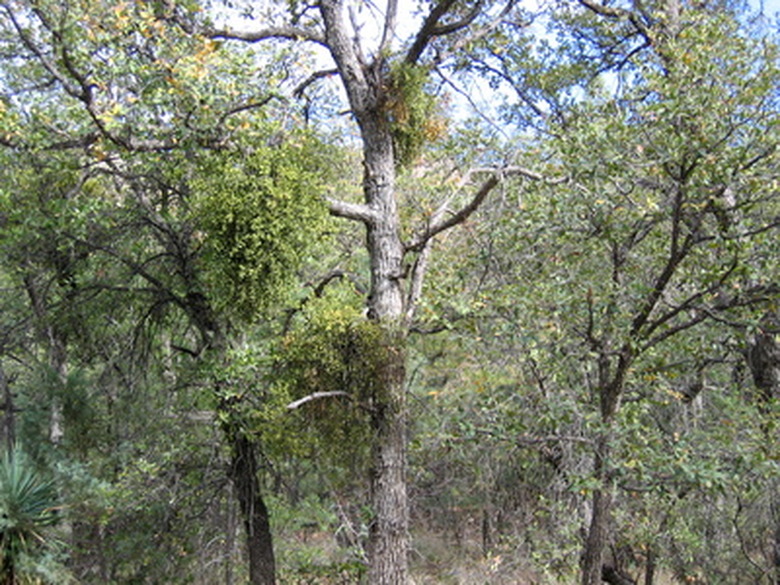Mistletoe On Desert Willow
While some people find mistletoe the perfect Christmas decoration, desert willows (Chilopsis linearis) find mistletoe a parasitic plant that it must tolerate. The species name, Phorodendron, can be translated to mean "tree thief," which accurately describes how mistletoe steals nutrients and water from its host plant. Mistletoe may harm the desert willow, but it also provides a valuable food resource for birds and wildlife who call the desert home.
Description
Mistletoe grows as a seed plant that gets most, if not all, of its nutrients from the host plant. The plant can also grow as a semi-parasitic plant that uses photosynthesis on its own while taking water and minerals from the host. Two mistletoe species grow in the Southwest desert, including P. californicum, a plant with small, narrow leaves. The other species includes P. tementosum var. macrophyllum, a plant sporting broad, thick leaves that appear opposite each other on the stem. Both plants produce flowers without petals and large numbers of inconspicuous seeds.
- While some people find mistletoe the perfect Christmas decoration, desert willows (Chilopsis linearis) find mistletoe a parasitic plant that it must tolerate.
- The species name, Phorodendron, can be translated to mean "tree thief," which accurately describes how mistletoe steals nutrients and water from its host plant.
How and Where Mistletoe Grows
Desert mistletoe occurs in the deserts of southern Nevada and California all the way south to the central part of Baja California and the southern Sonora in Mexico. Once a mistletoe seed germinates inside the young, thin bark of a desert willow tree, root-like growths start to grow in between the host plant's cells. The mistletoe sucks up water and nutrients from the willow tree, continuing to grow until its stems and leaves start covering the branches of the host plant.
Estimating the Age of Mistletoe
One of the oldest reported living mistletoes reached 419 years of age. To tell the age of a mistletoe, scientists count the tree rings from the region where the first root-like growths, called haustoria, appear in the host tree's bark. Mistletoe plants often reach 60 years of age and older.
Wildlife’s Role
A variety of birds rely on the berries and seeds of mistletoe, including the small silky flycatcher, also known as the Phainopepla. The stick seeds are coated with a gelatin-like material that helps the seeds stick to bird beaks and animal feet. After the birds eat the highly sticky seeds, a few seeds stick to their bills. When the birds fly to the desert willows or other trees in the area, they wipe their bills on the tree. These seeds then form new roots in the willow's young bark. Sometimes bird droppings also contain the seeds, which helps them spread and grow.
- Desert mistletoe occurs in the deserts of southern Nevada and California all the way south to the central part of Baja California and the southern Sonora in Mexico.
- To tell the age of a mistletoe, scientists count the tree rings from the region where the first root-like growths, called haustoria, appear in the host tree's bark.
Removing Mistletoe
Removing mistletoe from a desert willow remains difficult. Some gardeners try destroying the stems of the plant, but the roots of the mistletoe continue to grow new stems. Removing branches of the tree that are intertwined with mistletoe is another option, but it often ruins the look of the tree while possibly producing other problems due to the heavy pruning. Removing the target plant in a cultivated garden or landscape and controlling the source of the seeds offer the most effective ways of removing mistletoe permanently.
